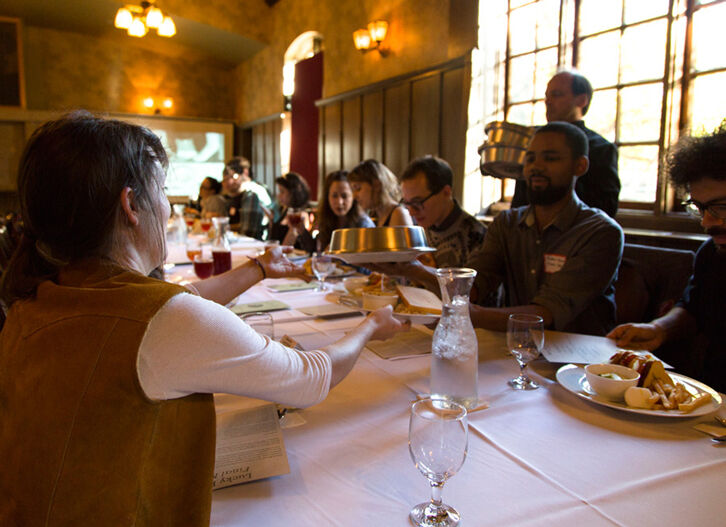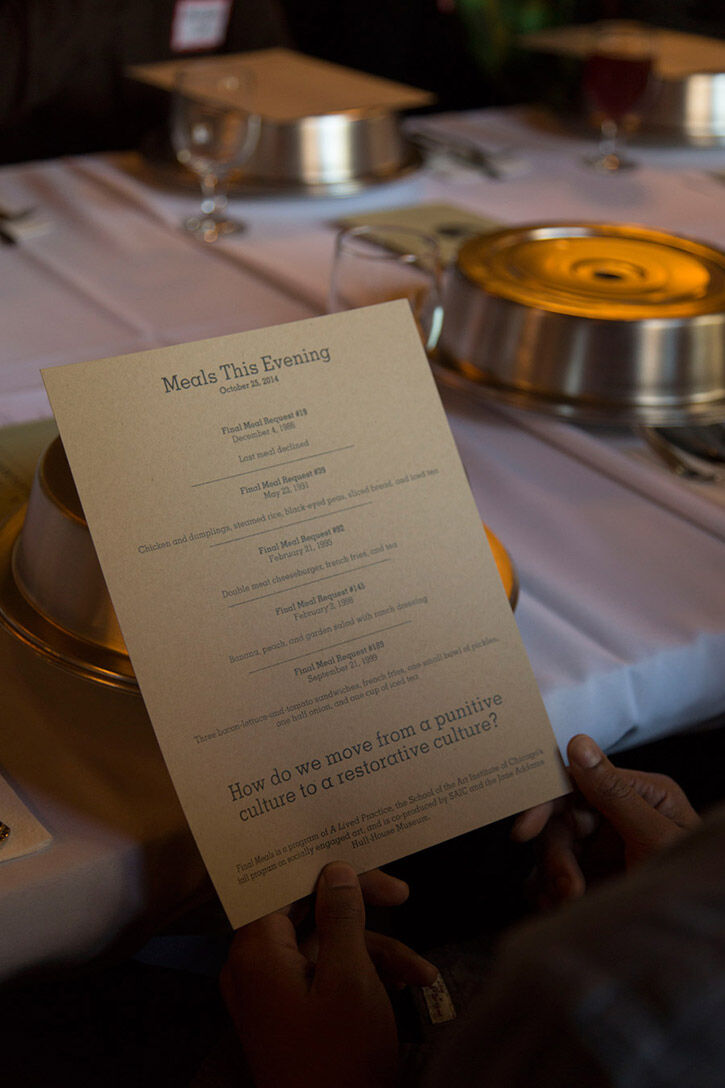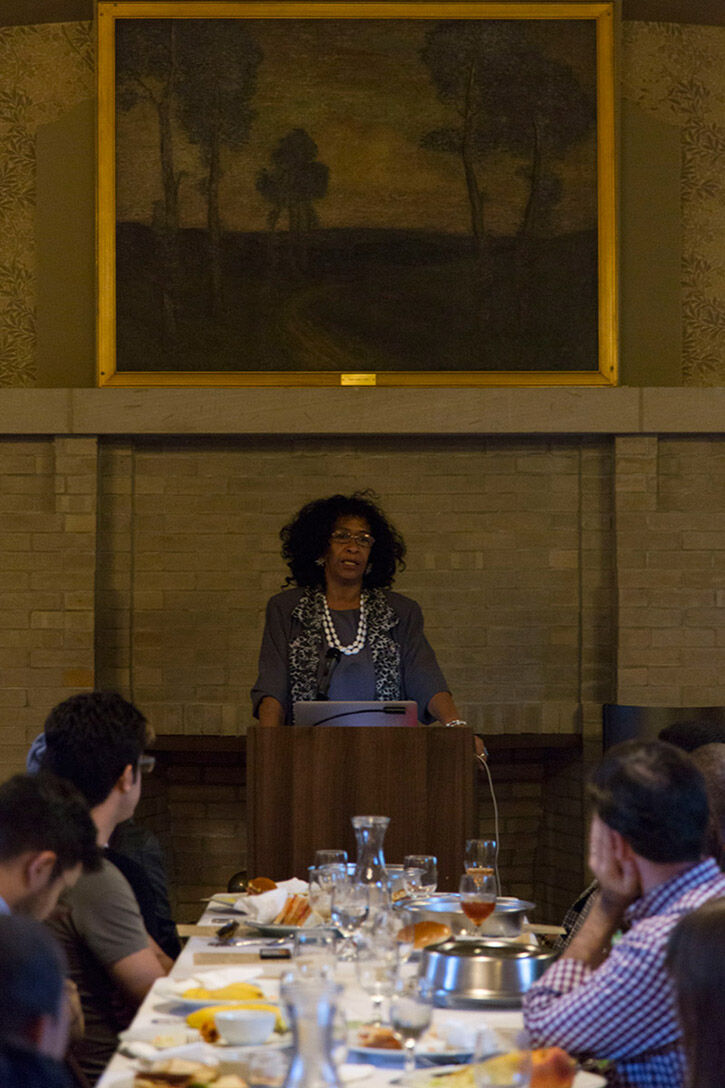
Serving Time

by Sammi Skolmoski (MFA 2016)
On October 25, 2014, a large group of community members including the SAIC-convened College Consortium for Art in Society, local government officials, and collaborative artist group Lucky Pierre gathered in the Residents' Dining Hall of the Jane Addams Hull-House Museum. Co-organized by SAIC's Department of Exhibitions and Exhibition Studies and the Hull-House Museum, the guests gathered around a "final meal" and conversation about prison reform.
Lisa Junkin Lopez (MA 2007), interim director of the Hull-House Museum and an SAIC faculty member, welcomed guests in the museum lobby, where she remarked on the life of Jane Addams and the duty of the museum to carry on her important work. She shared her favorite quote by Addams, which she regarded as a call to action for today's Chicagoans to continue the work of the Hull-House in an adaptive way.
"'The only thing to be dreaded in the Settlement is that it loses its flexibility, its power of quick adaptation, its readiness to change its methods as its environment may demand,'" Lopez read. "It must be open to conviction and must have a deep and abiding sense of tolerance. It must be hospitable and ready for experiment.'" She went on to note that this "is why collaborative, experimental events like tonight are so important to the Hull-House Museum—to take up that call."
After an invitation to explore the museum for an hour, guests were ushered into the historic dining hall—a large, wood-clad room set up with three long tables covered by white linens. Participants were instructed to take a covered plate from the catering table from one of five sections with labels that read "Final Meal Request #19," "Final Meal Request #39," "Final Meal Request #92," "Final Meal Request #145," or "Final Meal Request #189." There were no plates behind the "Final Meal #19" label, as it was later revealed that last meal request had been declined.
The content of the meals was selected from actual last meal requests of death row inmates published online by the Texas Department of Criminal Justice. The meal was curated by Lucky Pierre based on their ongoing interactive, community performance and film project, Final Meals, and this presentation of the project was coordinated as part of SAIC's A Lived Practice program.

"The posting of this information online by the state of Texas seemed a really unusual impulse," said Lucky Pierre artist and SAIC faculty member Kevin Kaempf. "The state seemed to highlight their efficiency in this really frightening area."
For the recording sessions of Final Meals, the members of Lucky Pierre chose a handful of requests, spent the day preparing the meals, and enlisted a volunteer to sit under a black-and-white camera to be filmed for 20 minutes as the food is consumed—or not. The project has been ongoing for more than a decade, and Lucky Pierre has re-created 197 of the 310 published final meals to date.
"We've accumulated hundreds of hours of video," Lucky Pierre member Heather Lindahl (MA 2015) explained. "Even if the meal was declined, we film the person for 20 minutes in front of an empty plate." Past Final Meals videos were projected onto the front of the dining hall throughout the event.
"We've done community meals like this a few times," Kaempf noted, "But this is by far the largest." This meal was catered by Nas Calihan (MFA 2008), who, with Lucky Pierre, chose which "final meals" would be served.
Some of the guests that evening were delighted by what they uncovered (Final Meal Request #145: banana, peach, and garden salad with ranch dressing); some were overwhelmed (Final Meal Request #92: double cheeseburger and French fries); and some were a little confused (Final Meal Request #189: three BLTs, French fries, one small bowl of pickles, and one half onion). As everyone ate their "small memorials to hunger," as Lucky Pierre cofounder Michael Thomas called them, he spoke about the development and history of the project and what it has meant to the members.
Thomas explained that no matter how long it might take them to complete all 310 meals—"If we ever do," he laughed—the number of meals would remain the same because the state no longer offered death row inmates a final meal. "It was a luxury the state said the condemned didn't deserve because the victims didn't get to choose their last meals," he said.
Lopez spoke next about the prison reform work accomplished by Addams and her settlement workers at the Hull-House. "The Hull-House residents were actually among a group of reformers who founded the nation's first juvenile court in 1899," she explained. "Previously children were tried the same way as adults, they were jailed alongside adults, and often children were being arrested for crimes of desperation. Addams and her colleagues began to think about what would it mean for the state to be a 'kind and just parent.'"
Lopez said that to further advance the work of the settlement workers the museum will continue to support juvenile rehabilitation reform until the state shifts from a role of punishment to one of protection. She also introduced two guest speakers, both formerly incarcerated activists working to transform prison policy to what she called "a restorative, rehabilitating culture," rather than the punitive system currently in place.
Benneth Lee, a community liaison for Illinois prisons through Treatment Alternatives for Safe Communities and cofounder of the National Alliance for the Empowerment of the Formerly Incarcerated, spoke first about his time in prison for gang involvement, and the problems he faced trying to reincorporate into society after his release.
Lee said he felt continually "stuck" long after he served his time. "Debt was paid by my time in prison and parole," he explained. "But I was further punished by society who disable people like me from moving forward by not giving us a job, or even a chance. My old ways kept money in my pocket and were looking pretty good, since no one would hire me."
By chance, he found a group of men facing similar reintegration issues who encouraged him to get his GED at 32 rather than revert to his "hustle game." Lee said, "We energize and normalize each other, and I'm so lucky I found them."
Since then he has received a master's degree in Leadership Development from Northeastern Illinois University, where he also teaches. He is working to turn convicted felons into a legally recognized class and voting block so that employment discrimination against former convicts would become illegal in the way that issues of race, gender, sexual orientation, and disability are now recognized and protected.

The second guest speaker, Geraldine Smith, is the founder of Life Builders United, a nonprofit grassroots organization that unites various programs in order to redirect the lives of those re-entering society after incarceration. Smith made history by becoming the first woman sentenced to death in Illinois after the death penalty was reinstated in 1977. Her execution was scheduled for May 20, 1998.
Smith served 19 years as the only female inmate on death row, but never succumbed to the repeated injustices she faced to the point of giving up her life for a crime she didn't commit. "My options were to be either a broken little kitten or a lioness to protect the others," she said. "I would not allow them to make me what they wanted me to be—insane, one who acted out, whined. I was crazy enough not to go mad."
She requested three business suits and three-inch heels from her sisters, wrote 500 letters to an attorney she had never met, and fought for her life. "I'm going to wear the shackles," she said. "They ain't going to wear me."
On the day of her release in 2008 she vowed to return to the prison as a beacon of hope for women inside who she says, if weak, "the prison will make them into people who will get stuck—or killed."
Her organization, Life Builders United, has so far helped 743 children redirect their lifestyle via accountability because Smith says she goes to see them and "demands they do right."
After the speeches, Lopez invited guests to remain at their tables and open a discussion with one another centered on the question, "How do we move from a punitive culture to a restorative culture?"
Kaempf commented that the experience of this community dinner would definitely impact future Final Meals events. "What was so poignant to us, the members of Lucky Pierre," he explained, "Was to hear the voices of people who have been directly impacted by these state policies and laws and bring us their direct and immediate visceral stories—that's something we will definitely take away from tonight."
"It was very special and only something that could have happened through the support from the Hull-House Museum."
